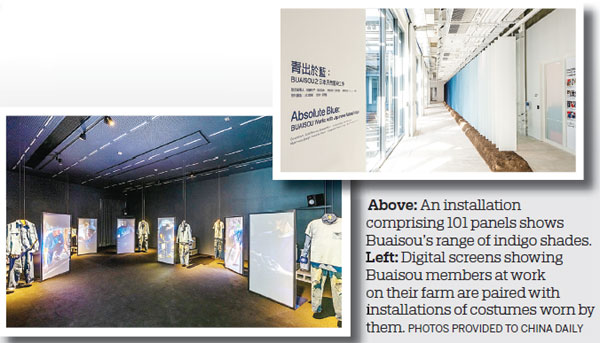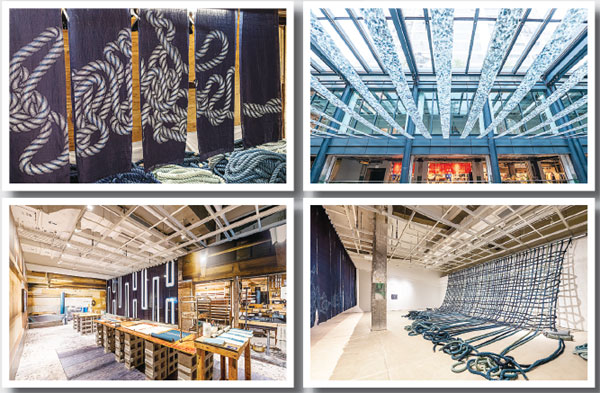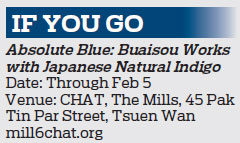
In 2018, following a revitalization project, the spinning factory buildings at 45 Pak Tin Par Road were reopened as The Mills - a cultural complex including retail and leisure facilities but, above all, a heritage space celebrating the history and craft of textiles. Showcasing the dignity and value of labor was high on the agenda from day one.
The mission continues with Absolute Blue: Buaisou Works with Japanese Natural Indigo, which opened on Oct 29. Hosted by the Centre for Heritage, Arts and Textile (CHAT), The Mills' museum and exhibition wing, the show puts the textile worker at its center.
Visitors get to vicariously experience a day in the life of Buaisou, a young craft collective based in Tokushima Prefecture, on the southern Japanese island of Shikoku. Their focus is on reinventing natural indigo for a contemporary audience. Founded in 2015, team Buaisou have made their mark by adapting traditional harvesting and dyeing techniques to new designs and current lifestyles while adhering to a sustainable farm-to-closet practice.
A highlight of the show is a pair of battered blue trousers, circa 1942 - a typical farmer's workwear on loan from the Tokushima Prefectural Museum. The fabric was woven on a loom using kozo (paper mulberry) fiber before being indigo dyed and hand-stitched. It's a precursor to Buaisou's hand-dyed jeans. Made for blue-collar workers - like the original American denim overalls of the 1870s - Buaisou trousers are designed with a loose fit to allow ease of movement.
 Clockwise from top left: Divided curtains bearing Buaisou's signature rope and cylinder tie-dye pattern; silk panels bearing the imprint of thousands of indigo leaves adorn The Mills courtyard; a game that takes its cue from the warp and weft of woven indigo fabric; a 1:1 reconstruction of Buaisou's studio in Tokushima as part of the Absolute Blue exhibition hosted by the Centre for Heritage, Art and Textiles in Tsuen Wan. Photos provided to China Daily
Clockwise from top left: Divided curtains bearing Buaisou's signature rope and cylinder tie-dye pattern; silk panels bearing the imprint of thousands of indigo leaves adorn The Mills courtyard; a game that takes its cue from the warp and weft of woven indigo fabric; a 1:1 reconstruction of Buaisou's studio in Tokushima as part of the Absolute Blue exhibition hosted by the Centre for Heritage, Art and Textiles in Tsuen Wan. Photos provided to China Daily Mizuki Takahashi, CHAT's executive director and chief curator, notes that a stiff new pair of jeans worn by a farm laborer becomes more malleable through rough use and frequent washing until it wraps "like a second skin". The exhibition highlights how work clothes can fuse with the wearer's persona, to the extent that it becomes a part of their identity.
An immersive video installation with multiple screens show Buaisou members at work on their farm. Each screen is paired with the denim work clothes belonging to the worker featured in it. It's as if the gloves, hat, neckerchiefs, jackets, trousers - ripped, discolored and frayed around the edges - bear the traces of human forms, and lives, that have inhabited them.
In The Mills courtyard, natural light pouring in from the skylight filters through horizontal panels across the ceiling. Hundreds of thousands of blue and green leaf prints on white silk create the feel of being in a shaded arbor. The patterns were made by pressing the leaves between layers of natural silk. The width of the panels - 38 or 45 centimeters - allude to the standard followed by traditional Japanese handloom makers. Be it temple banners or a kimono, the cloth is cut from running material of similar width.
Buiasou's collaborations with the likes of Nike and Jimmy Choo are probably owed to the collective's expertise at arriving at precise shades of blue. An installation of 101 vertical panels, showing the gradation from the palest to the darkest shade of indigo, demonstrates the range.

What really sets Buaisou apart, though, are the ingenious tweaks amplifying a time-honored craft. The collective's signature rope and cylinder tie-dye pattern is a variation on the traditional arashi shibori, whereby cloth is wrapped around a rod or water pipe before being dyed. Buaisou have added another layer to the technique by winding a rope around the wrapped fabric. The rope acts as a buffer against the dye from seeping in, leaving its imprint on the dyed surface.
The method is as low tech as it comes, and the results produced are a beautiful reminder of the value of repurposing tools often left idle at home.
basu@chinadailyhk.com
